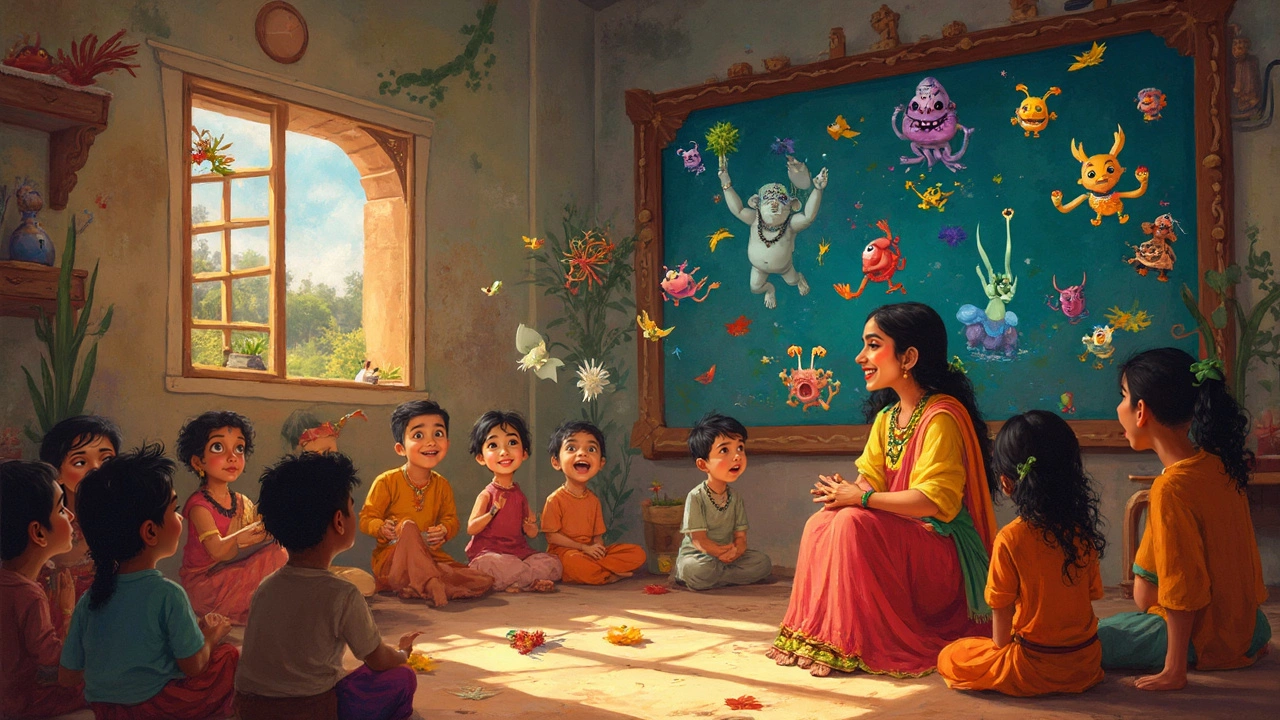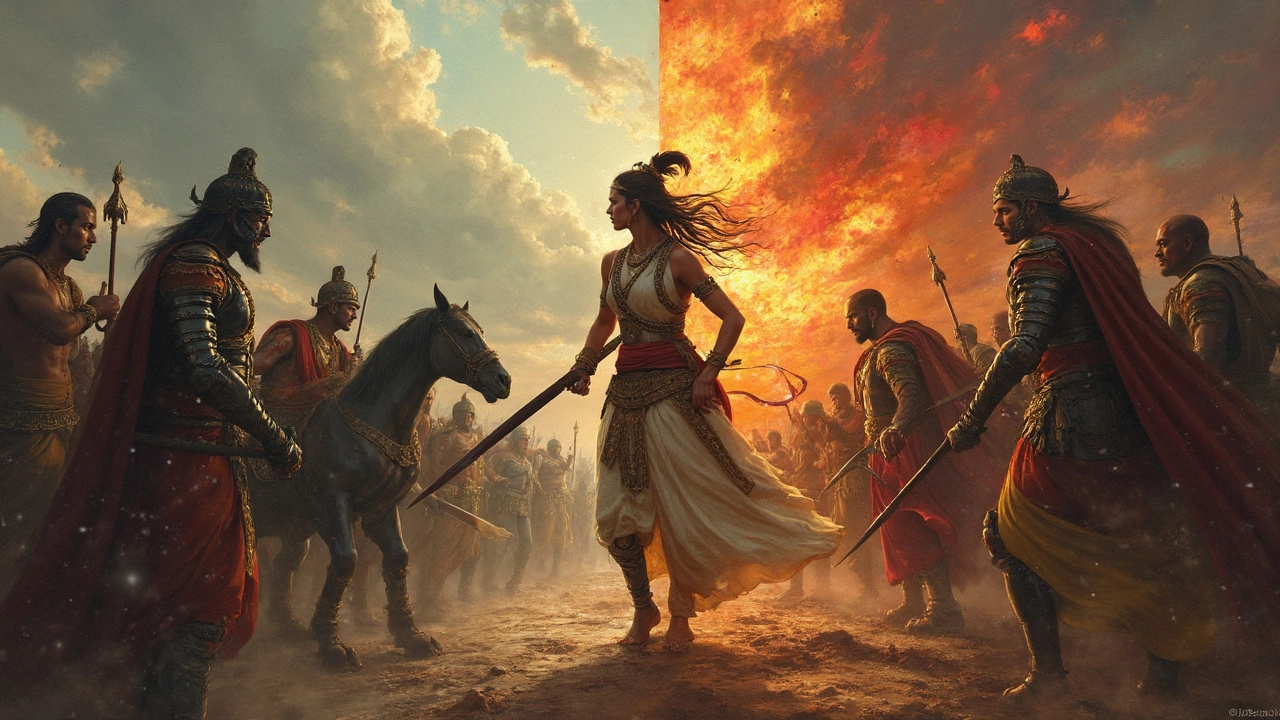Mythological Stories: What They Really Teach Us
 Jun, 7 2025
Jun, 7 2025
Would you believe the same stories that once explained thunder or the shape of a mountain also teach us who we are? Step into any myth, whether it’s Zeus tossing lightning or Anansi outsmarting everyone, and you’ll find more than just fantasy—they’re guides for living. Myths gave answers to big, scary questions way before science or psychology showed up. But here’s the wild part: the lessons still hit home, whether you’re dealing with a bad boss or figuring out what’s right and wrong.
Think about it—why did ancient people care so much about these stories? They needed comfort, clear rules, and heroes to root for (or villains to fear). But it wasn’t just bedtime entertainment. Myths smuggle in tips about loyalty, honesty, courage, and even when it’s okay to bend the rules a bit. You’ll find blueprints for handling tough choices, spotting troublemakers, and keeping your ego in check. Over the centuries, we swapped swords for smartphones, but the same myth-shaped lessons keep popping up, hiding in new forms—comic books, movies, even office gossip. Stick around to see how these old tales can actually make your life easier.
- Why People Needed Myths
- Basic Life Lessons in Myths
- Dealing with Good and Evil
- Modern Echoes of Ancient Myths
- Tips for Using Myths in Your Life
Why People Needed Myths
Before textbooks or Wikipedia, people turned to mythological stories to make sense of the world. Imagine sitting around a fire with no clue why the sun sets, why it rains, or why people get sick. Myths filled those gaps, turning natural mysteries into stories everyone could understand and remember.
Historically, most societies—like the Greeks, Egyptians, and Norse—used myths to explain everything from the weather to life and death. The Greeks blamed thunder on Zeus, while the Norse claimed Thor was swinging his hammer. These stories shaped what people feared, what they respected, and how they behaved.
But these myths did more than just explain stuff. They laid out community rules, teaching what was acceptable (and what wasn’t) long before written laws. For example, the ancient Code of Ur-Nammu—older than Hammurabi’s code—was passed down through stories and rituals, not just stone tablets. Myths talked about loyalty, honesty, betrayal, and revenge. Hearing about Prometheus being punished for stealing fire from the gods was way more memorable than a boring lecture on following rules.
Myths also gave people heroes to look up to or cautionary tales to avoid. Hercules’s strength inspired courage, while Icarus flying too close to the sun was a warning not to get cocky. These patterns show up everywhere: parents still use stories to get kids to behave, and popular movies recycle the same old ideas because they work.
Bottom line: people used myths to figure out how the world worked, create a sense of community, and set up basic life rules. Most of us don’t believe in thunder gods anymore, but we still crave stories that help us understand what’s going on and how we should act.
Basic Life Lessons in Myths
Mythological stories are more than old-time entertainment. They’re basically cheat codes for everyday living, packed with lessons most people can use right off the bat. Want proof? Let’s look at a few popular myths and see what they really say.
Take the Greek tale of Icarus—the guy who flew too close to the sun. He had wings made of feathers and wax. Who wouldn’t want to try flying, right? But Icarus ignored his dad’s warning. The result? Crash and burn, literally. The lesson here is super direct: know your limits and listen to people who know what they’re talking about. Overconfidence can cost you big time.
Or look at Norse myths. The trickster Loki causes chaos, but every time he bends the rules, there’s a price. These stories don’t just say “don’t be sneaky”—they show how cutting corners or lying usually backfires. There’s nothing subtle here: your choices come with consequences.
The Mahabharata, an epic from India, is loaded with family drama and tough moral choices. Arjuna, one of the main characters, has to decide if he’ll fight against his own relatives for what’s right. It’s not about swords and chariots—it’s about doing what’s right even when it’s hard, and sometimes walking away from an easy way out.
Here are a few classic life lessons you’ll spot in mythological stories across cultures:
- Don’t let pride lead the way (often seen with tragic heroes).
- Honesty is usually the best policy—even if it’s tough.
- Teamwork can beat unbeatable odds (think Jason and the Argonauts, or Odysseus’ crew).
- Greed usually wrecks everything. Just check out King Midas and his golden disaster.
- A little brainpower goes a long way (the underdog wins by outsmarting others).
If you scan modern stories, you’ll catch these same life lessons popping up. That’s because, deep down, we’re still dealing with the same human problems. Next time you read a myth or watch a movie with a heroic quest, try spotting these lessons—they’re still just as useful today as they were way back then.

Dealing with Good and Evil
Ever noticed how every myth throws some version of good against evil? Greek, Norse, Hindu, Native American—you name it, they all play with the same setup: heroes facing off against monsters, tricksters, or gods who bend the rules. The clash isn’t just for drama. It’s a way to explore real-life problems, like what makes a person good or why bad stuff happens even if you do your best.
Take the old Greek myth of Hercules. The guy gets twelve ridiculously hard labors, and each one pits him against some huge threat—a lion, a hydra, a giant boar. But here’s the catch: Hercules isn’t perfect. He gets angry, he messes up, he makes dumb choices. The story is showing us that doing the right thing takes work, patience, and honestly, screwing up along the way. It’s not so black and white.
Let’s get even more concrete. In Norse mythology, Loki keeps making trouble, flipping sides, and outsmarting the gods. But he isn’t pure evil—he’s clever, sometimes helpful, sometimes a disaster. Old myths use this gray area to say that real life isn’t just about picking sides. People can’t be shoved into neat boxes marked “hero” or “villain.”
Check out some of the ways myths break down good and evil:
- mythological stories love to show the costs of being good—think of Odysseus, who gets home only after losing friends and facing heartbreak. Every choice has payoffs and setbacks.
- Sometimes, villains become heroes later on, or heroes get corrupted. Like in the Mahabharata, where even the so-called good guys are forced to bend or break the rules to win.
- The “evil” side in myths often stands for chaos, selfishness, or greed—stuff found in every regular person. The stories ask: How do you deal with that part of yourself?
Myths do more than dish up good vs. evil—they ask us to look at why we choose what we do, and what happens next. The same thing shows up in real life: you don’t always face clear choices, and people aren’t 100% good or bad. Want proof these ideas have stuck? Check out some hard numbers below, showing how popular this basic theme still is in books and movies:
| Medium | % of Stories Featuring Good vs. Evil |
|---|---|
| Top 100 Bestselling Novels (2023) | 81% |
| Hollywood Blockbusters (2022) | 93% |
| Popular Streaming Shows (2024) | 86% |
The bottom line? These old-school tales of heroes and villains remind us that everyone deals with messy choices, and it’s never just bad guys vs. good guys. There’s always more going on under the surface.
Modern Echoes of Ancient Myths
It’s wild how ancient mythological stories haven’t really gone away—they’ve just changed outfits. Ever noticed why superhero movies feel a bit like Greek epics? That’s no accident. The Marvel and DC universes are packed with characters who borrow straight from gods and legendary heroes. Thor, for example, is literally lifted out of Norse mythology, hammer and all. Even Star Wars leans on old myth setups with chosen ones, wise mentors, dark forces, and epic journeys. George Lucas has said he leaned hard on Joseph Campbell’s work about mythic structures when putting the saga together.
But it’s not just in movies and comics. Advertising loves to use mythic ideas too. Think about brands that sell you the idea of “the hero’s journey” every time they pitch a car as the ticket to freedom, or shoes that promise you legendary speed. This stuff comes straight from narratives about quests and personal transformation.
Pop music and sports copy these themes as well. The underdog beating the odds is basically every legend retold—David versus Goliath all over again. Even the way we talk about tech wizards like Steve Jobs or Elon Musk—calling them visionaries, rebels, disruptors—feels like we’re building our own modern myths around real people.
Why do we keep recycling these old stories? Simple. Our brains love patterns. Myths made it easy to remember complex ideas, and that works just as well when you’re trying to explain a tech breakthrough or pitch the next big movie franchise. The big tip here: when you spot these myth echoes, you get better at seeing what messages you’re being sold and why certain stories grab your attention more than others.

Tips for Using Myths in Your Life
Mythological stories aren’t museum pieces. They’re practical tools you can use every day if you know where to look. People have done this for ages—turning ancient tales into everyday advice. Here’s how you can actually use mythological stories in your own life without sounding like a fortune teller.
- Spot Patterns in People: Notice any co-worker who keeps making the same mistakes? That’s the Greek myth of Sisyphus in real-time—pushing the same rock uphill, never learning. Myths clue you in on human habits.
- Use Stories to Problem-Solve: Stuck on a tough choice? Think like Odysseus. Map out your obstacles, list out wild options, and remember: sometimes the simplest way through is the best. Myths are packed with creative problem-solving moves.
- Check Your Ego: Narcissus fell for his own reflection. Remind yourself and your friends about this classic story. It’s a funny way to stay humble and skip drama.
- Get Kids Interested in Ethics: Myths have clear rights and wrongs. Tell them to kids at bedtime. It sticks better than just lecturing about good and bad behavior.
- Reframe Setbacks: Every hero messes up—Heracles, Thor, even Sun Wukong got things wrong. Use their stories as reminders that everyone stumbles and bounces back. That’s more helpful than perfection talk.
If you ever wondered how common this really is, check this out: surveys by the Pew Research Center found that 65% of adults in the US have used stories with mythological roots to teach kids values, whether through books, TV, or conversation. Even lots of therapy approaches borrow from myth patterns when working through personal problems.
| Myth Used | Modern Application |
|---|---|
| Icarus and Daedalus | Talking about risk and ambition in school settings |
| King Midas | Explaining greed and consequences in financial literacy classes |
| Pandora's Box | Discussing curiosity and responsibility in group therapy |
So, next time life gets a bit weird or tough, borrow some ancient wisdom. Myths have seen it all, and using them can make everyday choices and conversations way easier—and a little more fun.